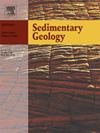晚中新世以来北冰洋锰铁地壳精细Os同位素地层学及其对极地环境变化的影响
IF 2.9
2区 地球科学
Q1 GEOLOGY
引用次数: 0
摘要
由于前第四纪沉积记录的数量有限,北极地区的长期环境史仍然受到限制。本文首次收集了北冰洋北风脊、门捷列夫脊、尼波维奇脊和沃林刺4个地点的氢成锰铁壳的Os同位素数据;水深从1300米到3851米不等。亚层(2 ~ 5mm厚)的Os浓度、187Os /188Os比值、主量元素和痕量元素组成呈现明显的时间变化。通过将门捷列夫海脊地壳的1870 /188Os年龄与新生代海水曲线的比值进行比较,利用门捷列夫海脊地壳的Be同位素年龄对FeMn地壳的1870 /188Os年龄进行了指导。这一结果大大改善了晚中新世和第四纪北极地壳地层的Os同位素时间记录。有几组元素在空间上表现出相似的行为(主要是Ti、Ba、U、REE、Y、Nb、Hf、Cd、Zr和Ni、Cu),两组元素在时间上表现出相似的行为(Fe、V、As和Ca、Co、Pb、Th)。时间历史的特征是放射性成因Os同位素组成的变化,这与长期(>;该地区105年的气候趋势,如中新世晚期变冷、上新世早至中期变暖和上新世-更新世北半球冰川作用。晚中新世FeMn地壳生长速率急剧下降,这可能是由于与Fram海峡最终拓宽和加深有关的底水条件的变化。本文章由计算机程序翻译,如有差异,请以英文原文为准。
Refined Os isotope stratigraphy of ferromanganese crusts from the Arctic Ocean and implications for polar environmental change since the late Miocene
The long-term environmental history of the Arctic region remains restricted due to the limited number of pre-Quaternary sedimentary records. We present the first Os isotope data of hydrogenetic ferromanganese crusts collected from four locations in the Arctic Ocean: Northwind Ridge, Mendeleev Ridge, Knipovich Ridge and Voring Spur; water depth varied from 1300 to 3851 m. The Os concentrations, 187Os /188Os ratios, and major- and trace-element compositions of sublayers (2–5 mm thick) show clear temporal variations. Be isotope ages determined for the Mendeleev Ridge crust were used to guide the 187Os /188Os ages of the Fe![]() Mn crusts, which were obtained by comparison of the 187Os /188Os ratios in the crusts with those of the Cenozoic seawater curve. The results greatly improve the Arctic Os isotope temporal record from Fe
Mn crusts, which were obtained by comparison of the 187Os /188Os ratios in the crusts with those of the Cenozoic seawater curve. The results greatly improve the Arctic Os isotope temporal record from Fe![]() Mn crust stratigraphy for the late Miocene and Quaternary.
Mn crust stratigraphy for the late Miocene and Quaternary.
Several groups of elements show similar behavior spatially (predominantly Ti, Ba, U, REE, Y, Nb, Hf, Cd, Zr, and Ni, Cu) and two groups temporally (Fe, V, As and Ca, Co, Pb, Th). The temporal history is characterized by variations in radiogenic Os isotope composition, which were associated with the long-term (> 105 yr) climatic trends in the region, such as late Miocene cooling, early-to-middle Pliocene warming, and Pliocene-Pleistocene Northern Hemisphere glaciation. The Fe![]() Mn crust growth rate decreased drastically in the late Miocene possibly due to changes in bottom water conditions associated with the final widening and deepening of the Fram Strait.
Mn crust growth rate decreased drastically in the late Miocene possibly due to changes in bottom water conditions associated with the final widening and deepening of the Fram Strait.
求助全文
通过发布文献求助,成功后即可免费获取论文全文。
去求助
来源期刊

Sedimentary Geology
地学-地质学
CiteScore
5.10
自引率
7.10%
发文量
133
审稿时长
32 days
期刊介绍:
Sedimentary Geology is a journal that rapidly publishes high quality, original research and review papers that cover all aspects of sediments and sedimentary rocks at all spatial and temporal scales. Submitted papers must make a significant contribution to the field of study and must place the research in a broad context, so that it is of interest to the diverse, international readership of the journal. Papers that are largely descriptive in nature, of limited scope or local geographical significance, or based on limited data will not be considered for publication.
 求助内容:
求助内容: 应助结果提醒方式:
应助结果提醒方式:


